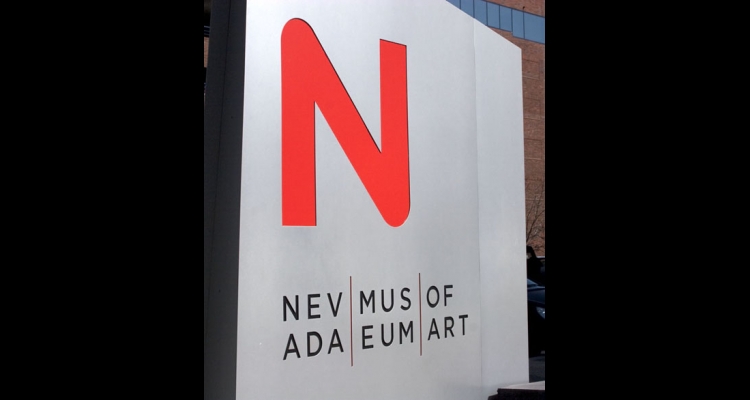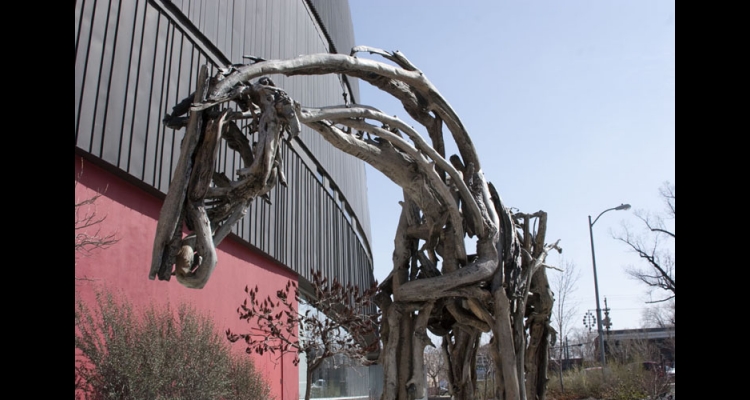Nevada Museum of Art
The Nevada Museum of Art (NMA), located in Reno, is the oldest cultural institution in the state. It was founded in 1931 as the Nevada Art Gallery and occupied three different locations before moving to its current home, the first designed specifically for the museum, in 2003.
The NMA's permanent collection includes over 2,000 paintings, drawings, prints, photographs, and sculptures, grouped into five thematic collections, all with a common thread of land environment. These collections are The Altered Landscape (contemporary landscape photographs), the Contemporary Collection (with a major focus on Nevada and West Coast artists), the Sierra Nevada|Great Basin Collection (focusing on the museum's home region over the last 150 years), the E. L. Wiegand Collection (focusing on the work ethic in American art), and the Historical Collection (American art primarily from 1900 to 1945).
The museum organizes exhibits from the works in their own collections, in combination with works borrowed from other institutions, and collaboratively with other arts organizations in the state and the region, and presents touring exhibitions as well. Exhibitions are accompanied by related special events such as receptions, lectures, workshops, films, and tours.
The NMA's E. L. Cord Museum School provides classes for children and adults in many artistic media—painting, ceramics, drama, video, sculpture, basketry, beadwork—as well as summer art camps and after-school programs for children. The Nell J. Redfield Discovery Center is an interactive educational gallery with hands-on activities and site-specific pieces by local artists. The museum's library of over 5,000 volumes and hundreds of films is another community resource. Group tours for schools and adults can be arranged, and regular exhibition tours each week are open to the public.
The NMA's newest addition is the Center for Art and Environment, which studies and presents various forms of "creative interactions between people and their natural, built and virtual environments." Established in 2008, the center collects, preserves, exhibits, and interprets artworks reflecting this theme.
The museum began its existence in 1931 as the Nevada Art Gallery, founded by Dr. James E. Church and art collector Charles F. Cutts and aided by the Latimer Art Club. Land was acquired at the north end of Arlington Avenue near the University of Nevada and a gallery building was planned. However, ongoing conflict with the university, which had originally been a partner in the effort, and the intervening hardships of the Depression and World War II, left the gallery without a permanent home until 1954. On Mr. Cutts's death in 1949 his house on Ralston Street along with his art collection and library were bequeathed to the Nevada Art Gallery and formed the foundation of its collection.
The gallery was managed by volunteers from the board of trustees and the Art Club, who organized exhibitions, gave tours, and presented talks. In 1959 a large exhibition space was added to the house. The Latimer Art Club stepped down from its role in managing the gallery in 1967, and the board moved toward professionalizing the museum with the hiring of its first director in 1975. In a short time, the trustees realized that a larger facility would be needed to accommodate the rapid development of the organization. The museum acquired the Hawkins house, a Georgian Revival home on Court Street on the bluffs above the Truckee River, and opened their first exhibition there in 1978. At the time of the move, the board also changed the name of the organization to the Sierra Nevada Museum of Art, reflecting their intention to focus on collecting the historical and contemporary art of the region.
The museum continued to grow, adding a museum school and new staff members. Marcia Growdon took over as director in 1981, and worked with the board to create an endowment to ensure the museum's continuity. The museum rapidly outgrew its new facility, so in 1988 they gladly accepted the donation of a commercial building on West Liberty Street from the E. L. Wiegand Foundation. A successful campaign was organized to raise funds to remodel the building into a museum space, and the new facility opened in early 1989, with a streamlined new name as well, the Nevada Museum of Art. The museum's next director, Richard Esparza, oversaw the revitalization of the museum school, the establishment of the E. L. Wiegand Collection, and the Altered Landscape Collection, and the museum's accreditation in 1993.
Steven High became the NMA's director in 1996 and led the campaign to design and fund a brand new building on the site of the previous structure. Designed by renowned architect Will Bruder, the new museum encompasses 60,000 square feet on four levels. The exhibition space is four times that of the old building, and there is more space for offices, collections storage, a sculpture garden, library, café and shop, and the museum school. The new building opened in 2003 to record crowds, and is a striking addition to Reno's Truckee River Arts District. Steven High left the museum in 2007, and the NMA is now under the direction of David B. Walker.
The NMA is accredited by the American Association of Museums, the only art museum in the state to be so recognized. The museum received the National Award for Museum Service in 1999 from the Institute of Museum and Library Services, and a Nevada Governor's Arts Award for Distinguished Service to the Arts in 2000.
The mission of the museum is the following: "We are a museum of ideas. While building upon our founding collections and values, we cultivate meaningful art and societal experiences, and foster new knowledge in the visual arts by encouraging interdisciplinary investigation. The Nevada Museum of Art serves as a cultural and educational resource for everyone." The NMA has a sizable staff and is headed by a board of directors made up of various community leaders. There is also an active group of several hundred volunteers who serve as docents, installation assistants, receptionists, and those who help with special events and receptions.







